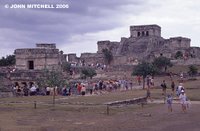
Not long ago, I revisited the ancient Maya city of Tulum on the Yucatán Peninsula's Caribbean coast, now known as the Riviera Maya. When I was last there in 1987, I walked past a few Maya vendors selling their handicrafts in the dusty parking lot and entered the walled archaeological site through a narrow gate. Once inside, I had the magical ruins and the idyllic white sand beaches stretching below Tulum’s windswept temples virtually all to myself.
This time, however, I was shocked to find a huge parking area crammed with tour buses, a sprawling indoor market with stacks of tacky souvenirs, plus a tractor-pulled “train” ferrying loads of tourists to a spiffy new ticket center with turnstiles and long lineups. To my dismay, most of Tulum’s buildings had been roped off, and I literally had to elbow my way through hordes of visitors in order to snap a few photos of the Temple of the Descending God and the Temple of the Frescoes, structures that I had explored freely on my first visit. Tulum still struck me as being an exceptionally beautiful place and well-worth visiting. But alas much of its former magic was absent, having been chased away by the very people who had come to experience it.
The Tulum archaeological zone is open daily 7 a.m. to 6 p.m. (8 a.m. to 6 p.m. in winter). Admission is about US$3.50. The train to the site’s entrance from the parking area costs around US$2. To avoid the worst of the crowds, get there at opening time or late in the afternoon.

No comments:
Post a Comment